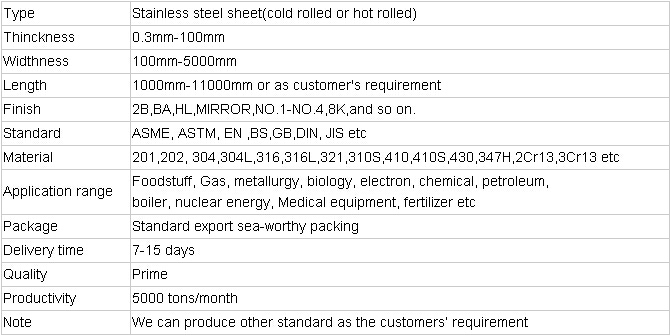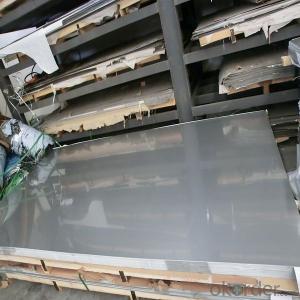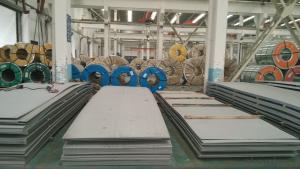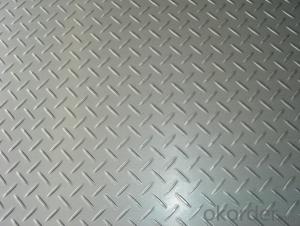Stainless Steel 304 sheet for exporting only
- Loading Port:
- Shanghai
- Payment Terms:
- TT OR LC
- Min Order Qty:
- 10000 m.t
- Supply Capability:
- 1000000 m.t/month
OKorder Service Pledge
Quality Product, Order Online Tracking, Timely Delivery
OKorder Financial Service
Credit Rating, Credit Services, Credit Purchasing
You Might Also Like
Stainless steel 304 sheet
Company advantage of stainless steel:
-Top Equipments, Leading In The Industry.
- Professional Team, Leading Innovation.
- Huge Supply Capacity Advantage, Timely and Effective Delivery.
- Modern Logistic, Fact and Convenient.
- Precise Manufacturing, Exquisite Products.
- Serve People, Create Value.
- Dimensional Network, Powerful Expansion.
Product Information of stainless steel sheet:


- Q:Can stainless steel pipes be used for petrochemical plants?
- Certainly, petrochemical plants can utilize stainless steel pipes. Due to its exceptional resistance to corrosion, stainless steel emerges as an optimal selection for such plants that deal with corrosive substances. These pipes possess the ability to endure extreme temperatures and pressures, rendering them appropriate for the demanding operational circumstances of petrochemical plants. Furthermore, stainless steel pipes exhibit outstanding mechanical qualities, guaranteeing their endurance and dependability within industrial settings. Moreover, the ease of cleaning and maintenance associated with stainless steel pipes minimizes the likelihood of contamination and enhances operational efficiency in petrochemical plants.
- Q:What is the difference between 304J3 and 316J3 stainless steel pipes?
- The composition and corrosion resistance properties distinguish 304J3 stainless steel pipes from 316J3 stainless steel pipes. 304J3 stainless steel is characterized by its 18% chromium and 8% nickel content. This grade is known for its excellent corrosion resistance, high strength, and good formability. It finds applications in various fields, including food processing, chemical processing, and architecture. In contrast, 316J3 stainless steel comprises 16-18% chromium, 10-14% nickel, and 2-3% molybdenum. The additional molybdenum enhances its corrosion resistance, particularly against chloride environments. Consequently, 316J3 stainless steel is commonly used in more demanding situations such as marine environments, pharmaceutical equipment, and coastal structures. To summarize, the main distinction between 304J3 and 316J3 stainless steel pipes lies in their composition and resulting corrosion resistance. While both grades provide good corrosion resistance, 316J3 stainless steel offers superior resistance in chloride-rich environments, making it suitable for more challenging applications.
- Q:How do you calculate the wall thickness for stainless steel pipes under external pressure?
- To calculate the wall thickness for stainless steel pipes under external pressure, you need to consider various factors such as the material properties, design codes, and the applied external pressure. Here is a general approach to calculating the wall thickness: 1. Determine the design pressure: The first step is to identify the external pressure that the stainless steel pipe will be subjected to. This pressure can be due to factors like fluid flow, environmental conditions, or operational requirements. 2. Determine the material properties: Stainless steel pipes have different grades, each with its own mechanical properties. Consult the material specifications to obtain the values for the yield strength (Sy) and ultimate tensile strength (Su) of the specific stainless steel grade you are working with. 3. Determine the allowable stress: The allowable stress (Sa) is the maximum stress that the material can sustain under the given conditions. It is usually provided by design codes or standards such as ASME B31.3 for process piping or ASME Section VIII for pressure vessels. 4. Calculate the design pressure thickness: Use the following formula to calculate the design pressure thickness (t): t = (P * D) / (2 * Sa) where P is the design pressure and D is the outside diameter of the stainless steel pipe. 5. Determine the corrosion allowance: Since stainless steel is prone to corrosion, it is important to consider a corrosion allowance to ensure the longevity of the pipe. The corrosion allowance is typically specified by the design codes or industry standards. 6. Calculate the final wall thickness: Add the corrosion allowance to the design pressure thickness calculated in step 4 to obtain the final wall thickness. It is important to note that this is a general approach, and specific design codes or standards may have additional requirements or factors to consider. Therefore, it is recommended to consult the relevant design codes, standards, or a qualified engineer to ensure accurate and safe calculations for your specific application.
- Q:Can stainless steel pipes be used for pulp and paper industry applications?
- Stainless steel pipes are indeed suitable for use in various applications within the pulp and paper industry. Due to their exceptional durability and resistance to corrosion, stainless steel pipes can be utilized in a range of industrial settings, including those found in the pulp and paper sector. This industry involves the transportation of corrosive substances and fluids, such as acids, bleaching agents, and solvents, which have the potential to deteriorate and erode standard pipes over time. Conversely, stainless steel pipes possess corrosion resistance properties, enabling them to endure the harsh chemicals and elevated temperatures typically encountered in pulp and paper plants. Furthermore, these pipes are also known for their hygienic nature and ease of cleaning, rendering them highly suitable for applications where cleanliness is of utmost importance, such as in the production of food-grade paper. In summary, stainless steel pipes represent a dependable and long-lasting choice for the pulp and paper industry.
- Q:The difference between galvanized steel pipe and stainless steel pipe
- Galvanized pipes are generally used for fire fighting and circulating water supply (non living water supply)
- Q:Can stainless steel pipes be used in the food processing industry?
- The food processing industry can make use of stainless steel pipes. Stainless steel is a preferred option in food processing because it possesses numerous advantageous qualities. Firstly, stainless steel's resistance to corrosion is vital in an environment where food and liquids are constantly being handled and processed. Additionally, stainless steel's easy maintenance and cleaning are crucial for ensuring hygiene and preventing contamination in food processing. Stainless steel pipes are also highly durable and strong, enabling them to withstand the demanding conditions of the food processing industry. Furthermore, stainless steel does not react chemically with food or ingredients, ensuring that the quality and taste of processed products remain unaffected. Overall, stainless steel pipes are an exceptional choice for the food processing industry due to their resistance to corrosion, cleanliness, durability, and non-reactive properties.
- Q:What's the easiest way to distinguish between stainless steel 202 and 304?
- They all belong to the austenitic stainless steel, 202 with Mn and N to replace part of nickel, so as to obtain the mechanical properties and good corrosion resistance, is a new type of stainless steel nickel, his strength at room temperature is higher than 304, there are no good oxidation resistance and magnetic strength in medium temperature below 800 degrees. Potions don't fly
- Q:What is the difference between seamless and electric resistance welded stainless steel pipes?
- The main difference between seamless and electric resistance welded stainless steel pipes lies in the manufacturing process. Seamless pipes are made from a solid stainless steel billet, which is heated and then stretched over a series of mandrels to create the desired shape and size. This process ensures a uniform and continuous structure without any welds. On the other hand, electric resistance welded pipes are made by forming flat stainless steel sheets into a cylindrical shape and then welding the edges together using an electric current. This results in a visible seam along the length of the pipe. While both types of pipes have their advantages and uses, seamless pipes are generally considered to have superior strength, corrosion resistance, and a smoother interior surface, making them suitable for applications where durability and cleanliness are crucial.
- Q:Can stainless steel pipes be used for chemical storage tanks?
- Indeed, stainless steel pipes have the capability to serve as chemical storage tanks. Renowned for its exceptional resistance to corrosion, stainless steel proves to be an optimal substance for the containment of chemicals. An extensive array of chemicals, such as acids, alkalis, solvents, and gases, face no challenge in penetrating its defenses. Furthermore, stainless steel boasts durability and strength, guaranteeing the structural integrity of the storage tanks. Moreover, its effortless cleaning and maintenance render it suitable for housing various types of chemicals. Nevertheless, one must exercise caution and thoroughly consider the specific properties and demands of the chemicals before opting for stainless steel pipes as chemical storage tanks.
- Q:Can stainless steel pipes be used for sewage pumping stations?
- Indeed, sewage pumping stations can utilize stainless steel pipes. Renowned for their resistance to corrosion, stainless steel proves to be an optimal material for sewage and wastewater applications. These pipes exhibit durability and strength, enabling them to endure the challenging circumstances and corrosive components present within sewage systems. Moreover, stainless steel exemplifies hygienic qualities and simplicity in cleaning, vital aspects for upholding the sanitation and effectiveness of a sewage pumping station. Consequently, stainless steel pipes establish themselves as a dependable and enduring selection for sewage pumping stations.
1. Manufacturer Overview |
|
|---|---|
| Location | |
| Year Established | |
| Annual Output Value | |
| Main Markets | |
| Company Certifications | |
2. Manufacturer Certificates |
|
|---|---|
| a) Certification Name | |
| Range | |
| Reference | |
| Validity Period | |
3. Manufacturer Capability |
|
|---|---|
| a)Trade Capacity | |
| Nearest Port | |
| Export Percentage | |
| No.of Employees in Trade Department | |
| Language Spoken: | |
| b)Factory Information | |
| Factory Size: | |
| No. of Production Lines | |
| Contract Manufacturing | |
| Product Price Range | |
Send your message to us
Stainless Steel 304 sheet for exporting only
- Loading Port:
- Shanghai
- Payment Terms:
- TT OR LC
- Min Order Qty:
- 10000 m.t
- Supply Capability:
- 1000000 m.t/month
OKorder Service Pledge
Quality Product, Order Online Tracking, Timely Delivery
OKorder Financial Service
Credit Rating, Credit Services, Credit Purchasing
Similar products
New products
Hot products
Related keywords
































